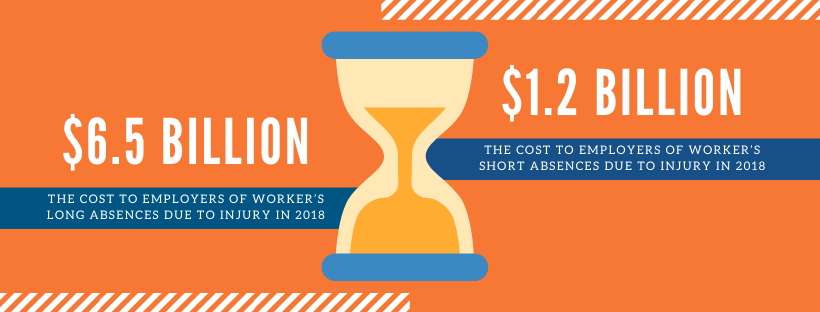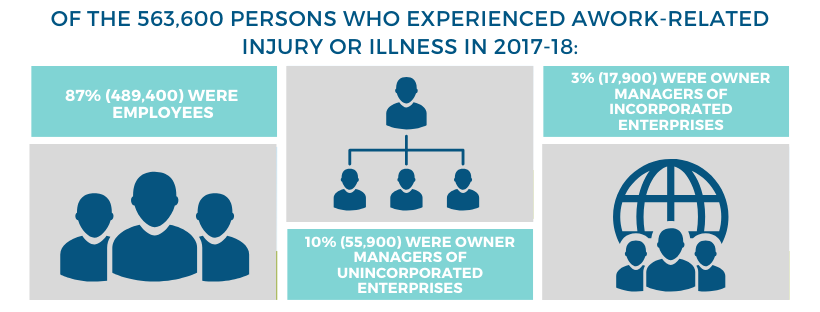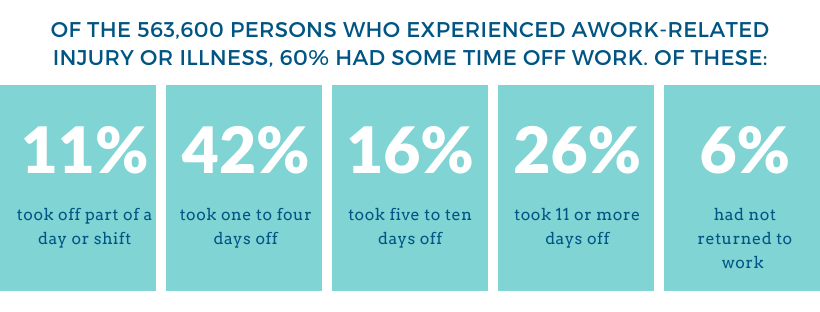The statistics are proof: work, wellbeing and general health are mutually beneficial. But a common belief among injured workers (and employers) is that ‘I need to be totally fit, well and completely recovered before returning to work’. Not true; good return to work outcomes are more likely when workers and employers understand the health benefits of work, and are empowered to return to work to aid their recovery.
Australian and New Zealand healthcare professionals, along with Government agencies, have been researching the topic since 2011 and have committed to a consensus statement regarding the positive relationship between health and work, and the negative consequences of long-term work absences.

Let’s hash it out.
Impacts of worklessness
Of all people who sustained an injury at work in 2018, 30% ended up leaving the workplace as a result of their injury or illness, and 16% were no longer working in the role in which the work-related injury occurred.
Numerous studies within Australia and globally have discovered that long-term worklessness leads to:
- A loss of self-esteem and identity within the community
- A halt to social participation and fulfillment
- 2 to 3 times poorer physical and mental health, as well as delayed recovery
- Financial stress and difficulties
- Higher hospital admission rates
- In extreme circumstances, increased mortality rates
If a person is off work for 20 days, their chance of returning is 70%; if they’re off work for 45 days, their chance of returning is 50%; and if they’re off work for 70 days, their chance of returning is only 35%. It’s fair to say that the associated costs of worklessness are substantial and often severe. But so too are the potential benefits for change.
Health benefits of work
Employer-supported, early return to work helps recovery, prevents de-conditioning and helps provide people with appropriate social contacts and support.
Rehabilitation is part of the recovery process, as is work; the challenge is changing perceptions to view it that way. But when listing the benefits of early return to work, it’s hard to ignore the advantages:
- Faster physical recovery and function as a result of movement
- Workers feel as though they are making a contribution to society, their family and community
- Provides a sense of pride, identity and personal achievement
- Enables workers to take part in social activities, build relationships and gain support
- Provides financial security and therefore independence
- Gives structure to days and weeks
- Improves self-esteem, self-satisfaction and gives workers the means to challenge and develop themselves
- Reduces psychological stress and improves mental health
- Decreases the likelihood that workers will engage in antisocial behaviours
- Leads to lower morbidity rates

So how do we (employers, workers, legislative bodies, Government) collectively promote the necessary shifts in understanding that work, in general, is good for return to work outcomes? Here are 7 simple steps for employers:
- Leadership – fostering and consistently demonstrating that safety in the workplace is crucial, will allow the adoption of a positive workplace culture from the top down.
- Policies and Procedures – ensure that the company has written Policies and Procedures in place to prevent workplace injuries and illness, which go beyond legislative requirements, and are specific to the business and industry. Embrace inclusive WHS best practices. And if you have existing Policies and Procedures in place, give them an audit to ensure they’re up to scratch.
- Safety Training – all safety training needs to be consistently reiterated, educated and implemented.
- Encouragement – offer encouragement and support to employees who are interested in staying fit and healthy. Provide some small health incentives or offer Corporate Wellness Programs where possible.
- Consult a Return to Work Provider – an industry expert will provide individual case management, assist employees to access medical care and treatment providers, provide progress reports and assist in an efficient return to work of the employee. They’ll also ensure that restoration of working life is closely alligned to clinical goals.
- Offer Suitable Duties – an injured worker may not be able to return to work in their full capacity straight away. Provide altered or alternate duties to get them back to work sooner, aid in recovery and improve productivity.
- Communication, communication, communication – keep lines of communication and support open for any injured worker and ensure you’re receiving regular updates from the Return to Work provider. The more active you are ensuring the worker still feels valued throughout the process, the faster their recovery and return to work is likely to be.
As Rehabilitation Providers and Return to Work Specialists, we know that most common health conditions will not be cured by treatment alone; work is a therapeutic intervention and should always be a part of the treatment process. We also know that employers play a big part in the return to work process; employer-supported return to work, positive communication and support is the best way forward to shift beliefs around recovery and work, and ultimately getting injured workers back to work sooner.
Related reading:
Video: 5 common workers’ comp questions answered
Why leadership and culture is imperative to safety
How to promote corporate wellness when it’s not your primary role
Case study: when altering your reactions can affect RTW outcomes


